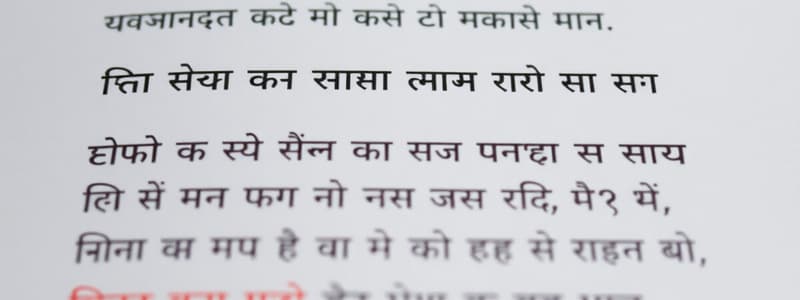Podcast
Questions and Answers
What language family does Hindi belong to?
What language family does Hindi belong to?
- Afro-Asiatic
- Niger-Congo
- Sino-Tibetan
- Indo-Aryan (correct)
Which of the following scripts is primarily used for writing Hindi?
Which of the following scripts is primarily used for writing Hindi?
- Cyrillic
- Devanagari (correct)
- Arabic
- Latin
What is the standard word order for sentences in Hindi?
What is the standard word order for sentences in Hindi?
- Subject-Object-Verb (correct)
- Verb-Subject-Object
- Subject-Verb-Object
- Object-Subject-Verb
Which dialect is considered the standard form of Hindi?
Which dialect is considered the standard form of Hindi?
What has significantly influenced modern Hindi vocabulary?
What has significantly influenced modern Hindi vocabulary?
Which statement about Hindi's official status is true?
Which statement about Hindi's official status is true?
What role does Hindi play in modern media?
What role does Hindi play in modern media?
What is emphasized in India's language policy regarding Hindi?
What is emphasized in India's language policy regarding Hindi?
Study Notes
Overview of Hindi
- Language Family: Indo-Aryan, part of the Indo-European language family.
- Number of Speakers: Approximately 600 million speakers, making it one of the most spoken languages globally.
- Geographic Distribution: Predominantly spoken in India; also in Nepal, Fiji, Mauritius, Suriname, and South Africa.
Script
- Primary Script: Devanagari
- Characteristics: Alphasyllabary; combines consonants and vowels.
- Direction: Written from left to right.
Dialects
- Major Dialects:
- Khari Boli (Standard Hindi)
- Awadhi
- Bhojpuri
- Magahi
- Bundeli
Grammar
- Word Order: Subject-Object-Verb (SOV).
- Nouns: Gendered (masculine or feminine).
- Verbs: Conjugation based on tense, aspect, and subject agreement.
- Cases: Uses postpositions to indicate grammatical relationships.
Vocabulary
- Origins:
- Sanskrit: Many formal and literary terms.
- Urdu: Shared vocabulary, especially in colloquial speech.
- English: Increasing influence, especially in modern contexts (tech, business).
Cultural Significance
- Official Status: One of the two official languages of the Government of India (along with English).
- Literature: Rich tradition including poetry, novels, and prose; notable authors include Premchand, Mahadevi Verma, and Harivansh Rai Bachchan.
- Media: Widely used in Bollywood films, music, and television, promoting global recognition.
Modern Usage
- Standardization: Hindi adopted as a medium of instruction in schools and universities.
- Digital Presence: Increasing use on social media, websites, and mobile applications.
- Language Policy: Emphasis on promoting Hindi while respecting linguistic diversity in multilingual India.
Resources for Learning
- Textbooks: Comprehensive Hindi language textbooks available for different proficiency levels.
- Online Courses: Many platforms offer Hindi language courses, emphasizing speaking and writing skills.
- Media: Hindi films, music, and news channels serve as immersive learning tools.
Hindi: An Overview
- Indo-Aryan Language: Part of the Indo-European language family.
- Widely Spoken: Approximately 600 million speakers worldwide, making it among the most spoken languages globally.
- Geographic Distribution: Predominantly spoken in India. Also prevalent in Nepal, Fiji, Mauritius, Suriname, and South Africa.
Script
- Devanagari: The primary script used for writing Hindi.
- Combines consonants and vowels (alphasyllabary).
- Written from left to right.
Dialects
- Khari Boli: Standard Hindi, the official language of India.
- Other major dialects: Awadhi, Bhojpuri, Magahi, and Bundeli.
Grammar
- Subject-Object-Verb (SOV) Word Order: The typical sentence structure in Hindi places the subject before the object and verb.
- Gendered Nouns: Hindi nouns are classified as masculine or feminine.
- Conjugated Verbs: Verbs change based on tense, aspect, and subject agreement.
- Postpositions: Used to indicate grammatical relationships, replacing prepositions.
Vocabulary
- Sanskrit Roots: Many formal and literary terms derive from Sanskrit.
- Shared Vocabulary with Urdu: Colloquial speech often shares vocabulary with Urdu.
- English Influence: Increasing adoption of English words, particularly in modern contexts like technology and business.
Cultural Significance
- Official Status: One of the two official languages of the Indian Government (along with English).
- Rich Literary Tradition: Hindi boasts a vast literary heritage including poetry, novels, and prose.
- Global Recognition through Media: Widely used in Bollywood films, music, and television, promoting its recognition globally.
Modern Usage
- Standardization: Hindi is utilized as a medium of instruction in schools and universities across India.
- Digital Presence: Growing use on social media, websites, and mobile applications.
- Language Policy: India promotes Hindi while respecting linguistic diversity across the nation.
Resources for Learning
- Comprehensive Textbooks: Available for different levels of Hindi proficiency.
- Online Courses: Various platforms offer courses emphasizing speaking and writing skills.
- Immersive Learning: Hindi films, music, and news channels serve as tools for language immersion.
Studying That Suits You
Use AI to generate personalized quizzes and flashcards to suit your learning preferences.
Description
Explore the key features of the Hindi language, including its family, number of speakers, and geographical distribution. This quiz will cover the script, major dialects, grammar rules, and vocabulary origins, providing a comprehensive understanding of Hindi.




